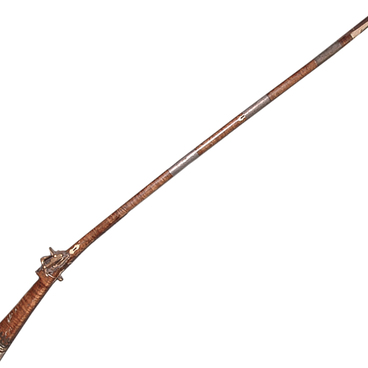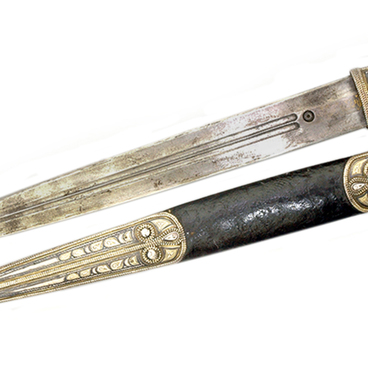Adyghe shashkas appeared relatively recently — in the 18th century. The name of this variety of sabre comes from the word seshkho which in the Adyghe language meant a long knife.
Shashka in scabbard
Время создания
early 20th century
Техника
silver, steel, leather, wood. Forge work, chasing, engraving, filigree, niello, granulation
11
Открыть в приложении#1
Shashka in scabbard
#4
#5
The interpreter and diplomat, a participant in the Caucasian War, Fyodor Tornau described the Adyghe sabre in the book Memoirs of a Caucasian Officer as follows:
‘This last, beloved and most terrible Circassian weapon consists of a sabre band, in a wooden, Morocco leather scabbard, with a handle without protection for the hand. The Circassian shashka is razor- sharp, and is used only for a blow, and not for protection; blows made with a shashka are for the most part fatal’.
#6
The Circassians themselves liked to say that ‘a shashka should be as light as a feather, as elastic as a vine, as sharp as a razor. He who carries a heavy shashka does not rely on skill’.
#2
The length of the curved shashka blade ranged from 72 to 76 centimetres. Its handle was made lightweight, and the centre of gravity was shifted closer to the tip. The main force of the blow fell precisely on this part of the blade.
#7
The shashka hilt did not have a cross-guard — a bar which in other varieties of cold weapons protected the fencer’s hand. The handle consisted of two flat halves, which were attached to the blade tang with rivets. They made it from horns or wood, often decorated with carved patterns. The shape of the bent pommel resembled a bird’s beak.
#8
The Adyghes carries shashkas in a wooden scabbard that was covered with leather and decorated with carved metal on-lays. The weapon in them did not become blunt over time, and also did not rattle during movement, thanks to which soldiers could move almost silently, unnoticed by opponents. In addition, such a scabbard reliably protected the blade from moisture, so it did not rust and remained operational for a long time.
To the shashka scabbard they attached sword-belt rings, which made it possible to carry weapons on a sling. Usually they were placed on the convex side. The Adyghes carried cold weapons with the cutting edge up and not down, as was customary among other peoples. To get, for example, a sabre or broadsword out of their scabbard one had to draw his hand with a blade to the right. Thus, the fencer lost a few fractions of a second, in which the enemy could strike. The Adyghes, however, removed the sabre from the scabbard right in front of them and could instantly engage in battle.
To the shashka scabbard they attached sword-belt rings, which made it possible to carry weapons on a sling. Usually they were placed on the convex side. The Adyghes carried cold weapons with the cutting edge up and not down, as was customary among other peoples. To get, for example, a sabre or broadsword out of their scabbard one had to draw his hand with a blade to the right. Thus, the fencer lost a few fractions of a second, in which the enemy could strike. The Adyghes, however, removed the sabre from the scabbard right in front of them and could instantly engage in battle.
читать дальшескрыть
00:00
00:00
1x
Shashka in scabbard
Время создания
early 20th century
Техника
silver, steel, leather, wood. Forge work, chasing, engraving, filigree, niello, granulation
11
Открыть в приложении
Поделиться

